Physical and Antibacterial Properties of Sodium Alginate—Sodium Carboxymethylcellulose Films Containing Lactococcus lactis
Abstract
1. Introduction
2. Discussion and Results
2.1. Survival of Lactococcus Lactis Strains
2.2. Morphology of the Films
2.3. Optical Properties of Films
2.4. Mechanical Properties of Films
2.5. Water Vapor Permeability
2.6. Film Moisture Content
2.7. Fourier Transform Infrared ( FT-IR) Spectrometry Analysis
2.8. Viability and Antimicrobial Activity of the Film
3. Materials and Methods
3.1. Materials
3.2. Preparation of the Bioactive Films
3.3. Determination of pH
3.4. Enumeration of Lactococcus lactis
3.5. Mechanical and Optical Properties
3.6. Water Vapor Permeability
3.7. Moisture Content
3.8. Surface Morphology and FT-IR Analysis
3.9. Viability and Antimicrobial Properties of the Films
3.10. Statistical Analysis
4. Conclusions
Author Contributions
Funding
Conflicts of Interest
References
- David, L.A.; Maurice, C.F.; Carmody, R.N.; Gootenberg, D.B.; Button, J.E.; Wolfe, B.E.; Ling, A.V.; Devlin, A.S.; Varma, Y.; Fischbach, M.A.; et al. Diet rapidly and reproducibly alters the human gut microbiome. Nature 2014, 505, 559–563. [Google Scholar] [CrossRef] [PubMed]
- Gibson, G.R.; Probert, H.M.; Loo, J.V.; Rastall, R.A.; Roberfroid, M.B. Dietary modulation of the human colonic microbiota: Updating the concept of prebiotics. Nutr. Res. Rev. 2004, 17, 259–275. [Google Scholar] [CrossRef] [PubMed]
- Nicholson, J.K.; Holmes, E.; Kinross, J.; Burcelin, R.; Gibson, G.; Jia, W.; Pettersson, S. Host-gut microbiota metabolic interactions. Science 2012, 336, 1262–1267. [Google Scholar] [CrossRef] [PubMed]
- Dastar, B.; Khosravi, A.; Boldajie, F.; Ghoorchi, T. Effect of calcium with and without probiotic, lactose, or both on organ and body weights, immune response and caecal microbiota in moulted laying hens. J. Anim. Physiol. Anim. Nutr. 2016, 100, 243–250. [Google Scholar] [CrossRef] [PubMed]
- Remus, D.M.; Kleerebezem, M.; Bron, P.A. An intimate tête-à-tête-how probiotic lactobacilli communicate with the host. Eur. J. Pharmacol. 2011, 668, 33–42. [Google Scholar] [CrossRef] [PubMed]
- Karczewski, J.; Troost, F.J.; Konings, I.; Dekker, J.; Kleerebezem, M.; Brummer, R.J.; Wells, J.M. Regulation of human epithelial tight junction proteins by Lactobacillus plantarum in vivo and protective effects on the epithelial barrier. Am. J. Physiol.-Gastrointest. Liver Physiol. 2010, 298, 851–859. [Google Scholar] [CrossRef] [PubMed]
- Ghanbari, M.; Jami, M.; Domig, K.J.; Kneifela, W. Seafood biopreservation by lactic acid bacteria-a review. LWT-Food Sci. Technol. 2013, 54, 315–324. [Google Scholar] [CrossRef]
- Soukoulis, C.; Yonekura, L.; Gan, H.H.; Behboudi-Jobbehdar, S.; Parmenter, C.; Fisk, I.D. Probiotic edible films as a new strategy for developing functional bakery products: The case of pan bread. Food Hydrocoll. 2014, 39, 231–242. [Google Scholar] [CrossRef] [PubMed]
- Romano, N.; Tavera-Quiroz, M.J.; Bertola, N.; Mobili, P.; Pinotti, A.; Gómez-Zavaglia, A. Edible methylcellulose-based films containing fructo-oligosaccharides as vehicles for lactic acid bacteria. Food Res. Int. 2014, 64, 560–566. [Google Scholar] [CrossRef] [PubMed]
- Beristain-Bauza, S.D.; Mani-López, E.; Palou, E.; López-Malo, A. Antimicrobial activity of whey protein films supplemented with lactobacillus sakei cell-free supernatant on fresh beef. Food Microbiol. 2017, 62, 207–211. [Google Scholar] [CrossRef] [PubMed]
- Degli Esposti, M.; Toselli, M.; Sabia, C.; Messi, P.; Niederhäusern, S.D.; Bondi, M.; Iseppi, R. Effectiveness of polymeric coated films containing bacteriocin-producer living bacteria for listeria monocytogenes, control under simulated cold chain break. Food Microbiol. 2018, 76, 173–179. [Google Scholar] [CrossRef] [PubMed]
- Sánchez-González, L.; Saavedra, J.I.Q.; Chiralt, A. Antilisterial and physical properties of biopolymer films containing lactic acid bacteria. Food Control 2014, 35, 200–206. [Google Scholar] [CrossRef]
- Gialamas, H.; Zinoviadou, K.G.; Biliaderis, C.G.; Koutsoumanis, K.P. Development of a novel bioactive packaging based on the incorporation of lactobacillus sakei into sodium-caseinate films for controlling listeria monocytogenes in foods. Food Res. Int. 2010, 43, 2402–2408. [Google Scholar] [CrossRef]
- Sánchez-González, L.; Saavedra, J.I.Q.; Chiralt, A. Physical properties and antilisterial activity of bioactive edible films containing Lactobacillus plantarum. Food Hydrocoll. 2013, 33, 92–98. [Google Scholar] [CrossRef]
- Soukoulis, C.; Behboudi-Jobbehdar, S.; Yonekura, L.; Parmenter, C.; Fisk, I.D. Stability of Lactobacillus rhamnosus GG in prebiotic edible films. Food Chem. 2014, 159, 302–308. [Google Scholar] [CrossRef] [PubMed]
- Kanmani, P.; Lim, S.T. Development and characterization of novel probiotic-residing pullulan/starch edible films. Food Chem. 2013, 141, 1041–1049. [Google Scholar] [CrossRef] [PubMed]
- Iseppi, R.; de Niederhäusern, S.; Anacarso, I.; Messi, P.; Sabia, C.; Pilati, F.; Toselli, M.; Esposti, M.D.; Bondi, M. Anti-listerial activity of coatings entrapping living bacteria. Soft Matter 2011, 7, 8542. [Google Scholar] [CrossRef]
- Settier-Ramírez, L.; López-Carballo, G.; Gavara, R.; Hernández-Muñoz, P. Antilisterial properties of PVOH-based films embedded with Lactococcus lactis subsp. Lactis. Food Hydrocoll. 2019, 87, 214–220. [Google Scholar] [CrossRef]
- Dehghani, S.; Hosseini, S.V.; Regenstein, J.M. Edible films and coatings in seafood preservation: A review. Food Chem. 2017, 240, 505–513. [Google Scholar] [CrossRef] [PubMed]
- Hamedi, H.; Kargozarib, M.; Shotorbanic, P.M.; Mogadamd, N.B.; Fahimdaneshe, M. A novel bioactive edible coating based on sodium alginate and galbanum gum incorporated with essential oil of ziziphora persica: The antioxidant and antimicrobial activity, and application in food model. Food Hydrocoll. 2017, 72, 35–46. [Google Scholar] [CrossRef]
- Tavera-Quiroz, M.J.; Romano, N.; Mobili, P.; Pinotti, A.; Gómez-Zavagliaet, A.; Bertola, N. Green apple baked snacks functionalized with edible coatings of methylcellulose containing Lactobacillus plantarum. J. Funct. Foods 2015, 16, 164–173. [Google Scholar] [CrossRef]
- Fu, N.; Chen, X.D. Towards a maximal cell survival in convective thermal drying processes. Food Res. Int. 2011, 44, 1127–1149. [Google Scholar] [CrossRef]
- Ghandi, A.; Powell, I.; Chen, X.D.; Adhikari, B. Drying kinetics and survival studies of dairy fermentation bacteria in convective air drying environment using single droplet drying. J. Food Eng. 2012, 110, 405–417. [Google Scholar] [CrossRef]
- Burgain, J.; Gaiani, C.; Francius, G.; Revol-Junelles, A.M.; Cailliez-Grimal, C.; Lebeer, S.; Tytgat, H.L.P.; Vanderleyden, J.; Scher, J. In vitro interactions between probiotic bacteria and milk proteins probed by atomic force microscopy. Coll. Surf. B 2013, 104, 153–162. [Google Scholar] [CrossRef] [PubMed]
- Jeya Shakila, R.; Jeevithan, E.; Varatharajakumar, A.; Jeyasekaran, G.; Sukumar, D. Comparison of the properties of multi-composite fish gelatin films with that of mammalian gelatin films. Food Chem. 2014, 135, 2260–2267. [Google Scholar] [CrossRef] [PubMed]
- Odila Pereira, J.; Soares, J.; Sousa, S.; Madureira, A.R.; Gomes, A.; Pintado, M. Edible films as carrier for lactic acid bacteria. LWT-Food Sci. Technol. 2016, 73, 543–550. [Google Scholar] [CrossRef]
- Beristain-Bauza, S.C.; Mani-López, E.; Palou, E.; López-Malo, A. Antimicrobial activity and physical properties of protein films added with cell-free supernatant of lactobacillus rhamnosus. Food Control 2016, 62, 44–51. [Google Scholar] [CrossRef]
- Ward, G.; Nussinovitch, A. Gloss properties and surface morphology relationships of fruits. J. Food Sci. 1996, 61, 973–977. [Google Scholar] [CrossRef]
- Ly, M.H.; Aguedo, M.; Goudot, S.; Le, M.L.; Cayot, P.; Teixeira, J.A.; Le, T.M.; Belin, J.-M.; Waché, Y. Interactions between bacterial surfaces and milk proteins, impact on food emulsions stability. Food Hydrocoll. 2008, 22, 742–751. [Google Scholar] [CrossRef]
- Brachkova, M.I.; Duarte, A.; Pinto, J.F. Alginate films containing viable Lactobacillus plantarum: Preparation and in vitro evaluation. AAPS PharmSciTech 2012, 13, 357. [Google Scholar] [CrossRef] [PubMed]
- Benbettaïeb, N.; Kurek, M.; Bornaz, S.; Debeaufort, F. Barrier, structural andmechanical properties of bovine gelatin–chitosan blend films related to biopolymer interactions. J. Sci. Food Agric. 2014, 94, 2409–2419. [Google Scholar] [CrossRef] [PubMed]
- Soukoulis, C.; Behboudi-Jobbehdar, S.; Macnaughtan, W.; Parmenter, C.; Fisk, I.D. Stability of lactobacillus rhamnosus GG incorporated in edible films: Impact of anionic biopolymers and whey protein concentrate. Food Hydrocoll. 2017, 70, 345–355. [Google Scholar] [CrossRef] [PubMed]
- Ebrahimi, B.; Mohammadi, R.; Rouhi, M.; Mortazavian, A.M.; Shojaee-Aliabadi, S.; Koushki, M.R. Survival of probiotic bacteria in carboxymethyl cellulose-based edible film and assessment of quality parameters. LWT-Food Sci. Technol. 2017, 87. [Google Scholar] [CrossRef]
- Liu, Z.; Li, X.; Xie, W.; Deng, H. Extraction, isolation and characterization of nanocrystalline cellulose from industrial kelp (laminaria japonica) waste. Carbohyd. Polym. 2017, 173, 353–359. [Google Scholar] [CrossRef] [PubMed]
- Tako, M.; Higa, M.; Medoruma, K.; Nakasone, Y. A highly methylated agar from red seaweed. Bot. Mar. 1999, 42, 513–517. [Google Scholar] [CrossRef]
- Wang, L.F.; Rhim, J.W. Preparation and application of agar/alginate/collagen ternary blend functional food packaging films. Int. J. Biol. Macromol. 2015, 80, 460–468. [Google Scholar] [CrossRef] [PubMed]
- Chirapart, A.; Ohno, M.; Ukeda, H.; Sawamura, M.; Kusunose, H. Chemical composition of agars from a newly reported japanese agarophyte, gracilariopsis lemaneiformis. J. Appl. Phycol. 1995, 7, 359–365. [Google Scholar] [CrossRef]
- Guerrero, P.; Etxabide, A.; Leceta, I.; Peñalba, M.; de la Caba, K. Extraction of agar from gelidium sesquipedale (Rodhopyta) and surface characterization of agar based films. Carbohyd. Polym. 2014, 99, 491–498. [Google Scholar] [CrossRef] [PubMed]
- Tavera-Quiroz, M.J.; Lecot, J.; Bertola, N.; Pinotti, A. Stability of methylcellulose-based films after being subjected to different conservation and processing temperatures. Mat. Sci. Eng. C-Mater. 2013, 33, 2918–2925. [Google Scholar] [CrossRef] [PubMed]
- Dong, Q.Y.; Chen, M.Y.; Xin, Y.; Qin, X.Y.; Cheng, Z.; Shi, L.E.; Tang, Z.X. Alginatebased and protein-based materials for probiotics encapsulation: A review. Int. J. Food Sci. Technol. 2013, 48, 1339–1351. [Google Scholar] [CrossRef]
- Natrajan, N.; Sheldon, B.W. Efficacy of nisin-coated polymer films to inactivate salmonella typhimurium on fresh broiler skin. J. Food Prot. 2000, 63, 1189–1196. [Google Scholar] [CrossRef] [PubMed]
- Behboudi-Jobbehdar, S.; Soukoulis, C.; Yonekura, L.; Fisk, I. Optimization of spray-drying process conditions for the production of maximally viable microencapsulated L. acidophilus NCIMB 701748. Dry. Technol. 2013, 31, 1274–1283. [Google Scholar] [CrossRef]
- López De Lacey, A.M.; López-Caballero, M.E.; Gómez-Estaca, J.; Gómez-Guillén, M.C.; Montero, P. Functionality of Lactobacillus acidophilus and Bifidobacterium bifidum incorporated to edible coatings and films. Innov. Food Sci. Emerg. 2012, 16, 277–282. [Google Scholar] [CrossRef]
- Champagne, C.P.; Ross, R.P.; Saarela, M.; Hansen, K.F.; Charalampopoulos, D. Recommendations for the viability assessment of probiotics as concentrated cultures and in food matrices. Int. J. Food Microbiol. 2011, 149, 185–193. [Google Scholar] [CrossRef] [PubMed]
- Piermaria, J.; Diosma, G.; Aquino, C.; Garrote, G.; Abraham, A. Edible kefiran films as vehicle for probiotic microorganisms. Innov. Food Sci. Emerg. 2015, 32, 193–199. [Google Scholar] [CrossRef]
- Kurek, M.; Galus, S.; Debeaufort, F. Surface, mechanical and barrier properties of bio-based composite films based on chitosan and whey protein. Food Packag. Shelf Life 2014, 1, 56–67. [Google Scholar] [CrossRef]
- Kristo, E.; Koutsoumanis, K.P.; Biliaderis, C.G. Thermal, mechanical and water vapor barrier properties of sodium caseinate films containing antimicrobials and their inhibitory action on Listeria monocytogenes. Food Hydrocoll. 2008, 22, 373–386. [Google Scholar] [CrossRef]
Sample Availability: Samples of the compounds are available from the authors. |
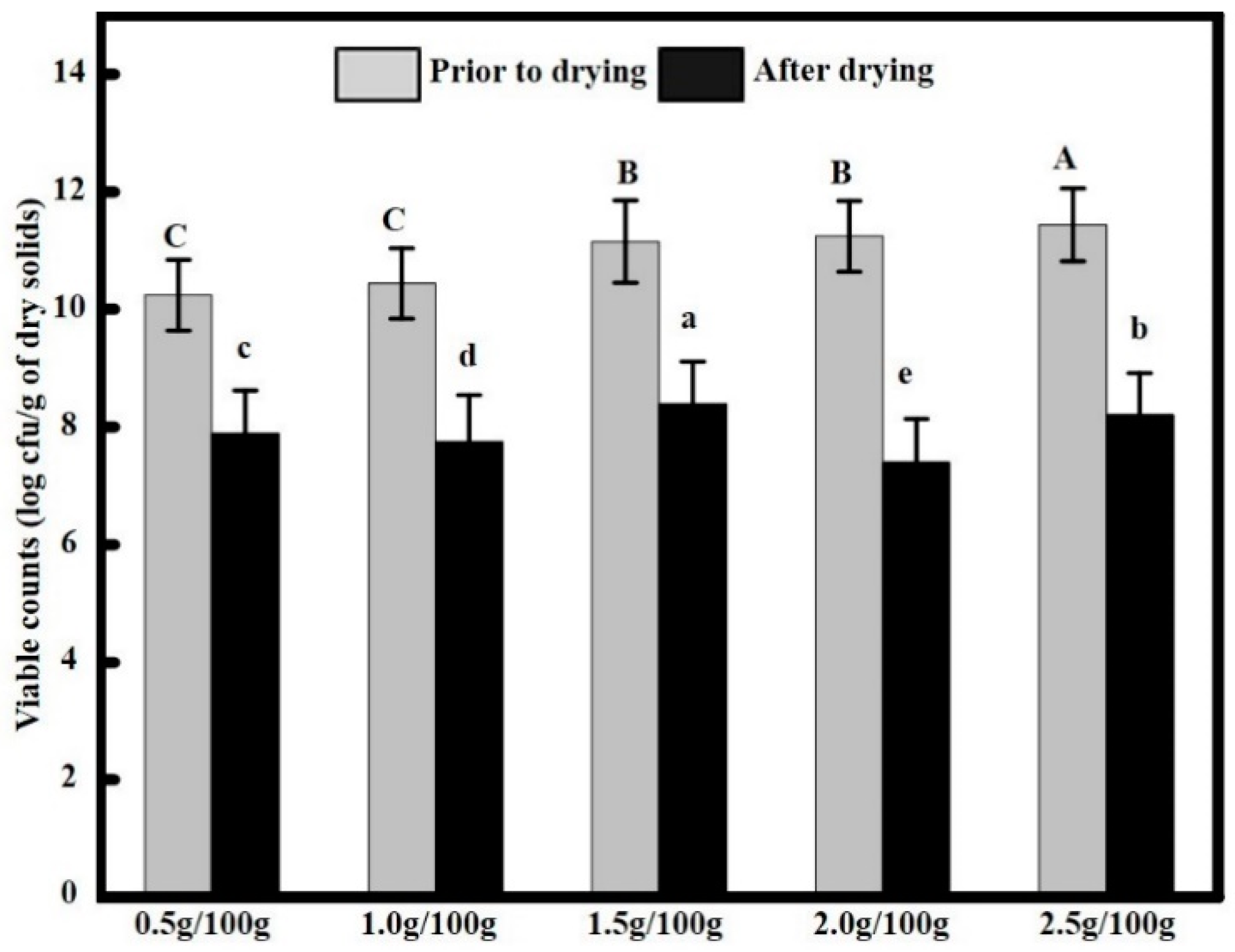
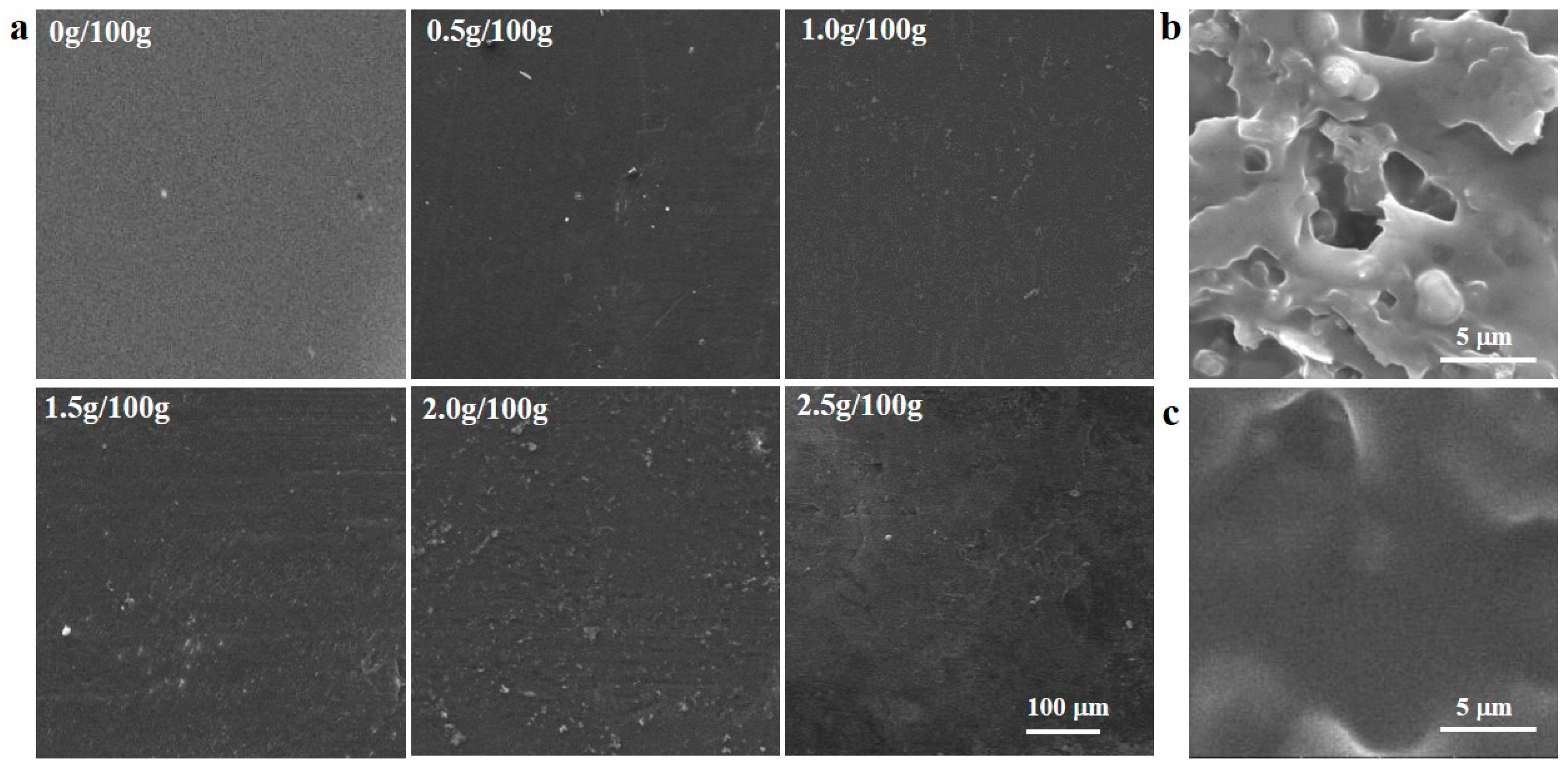
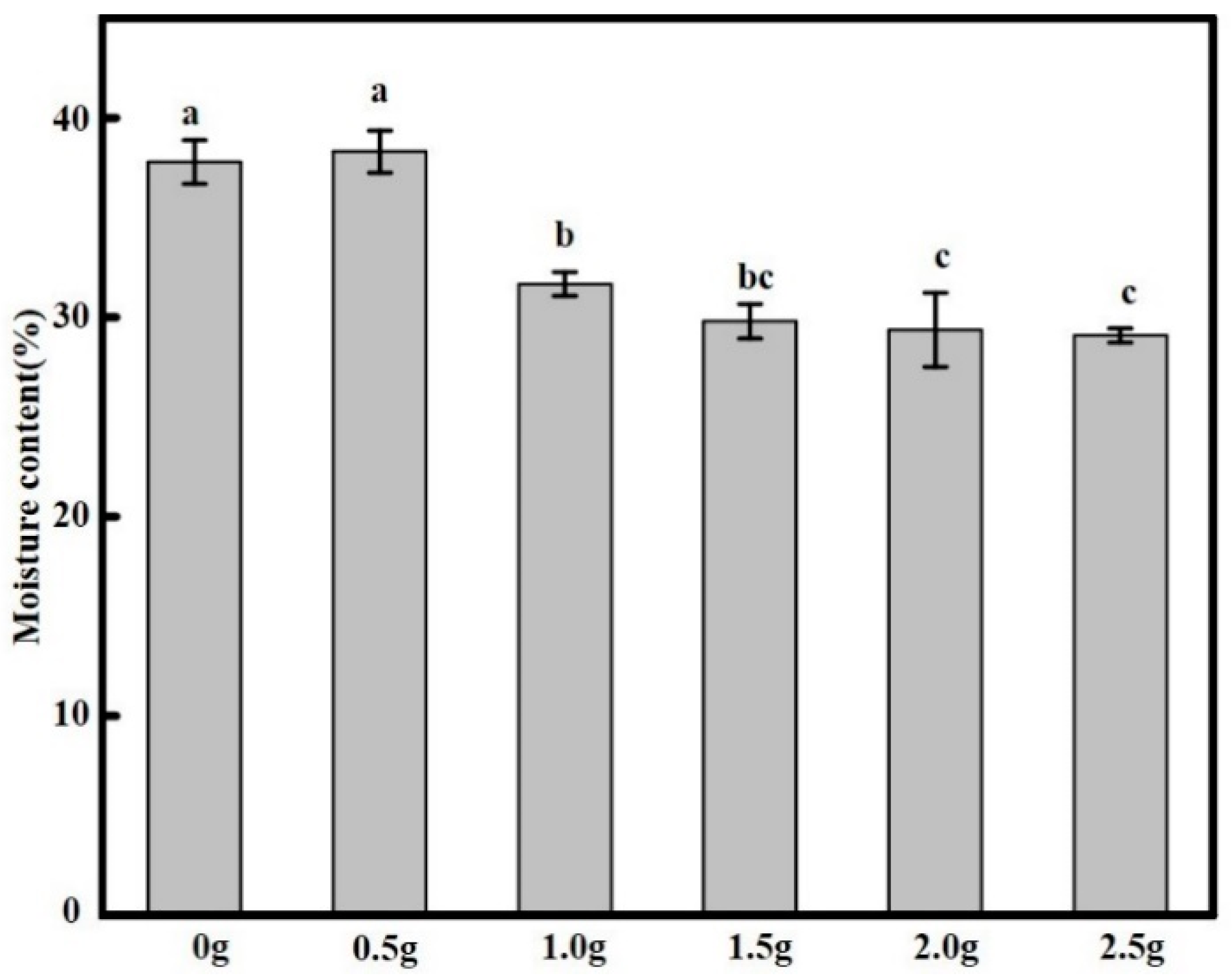
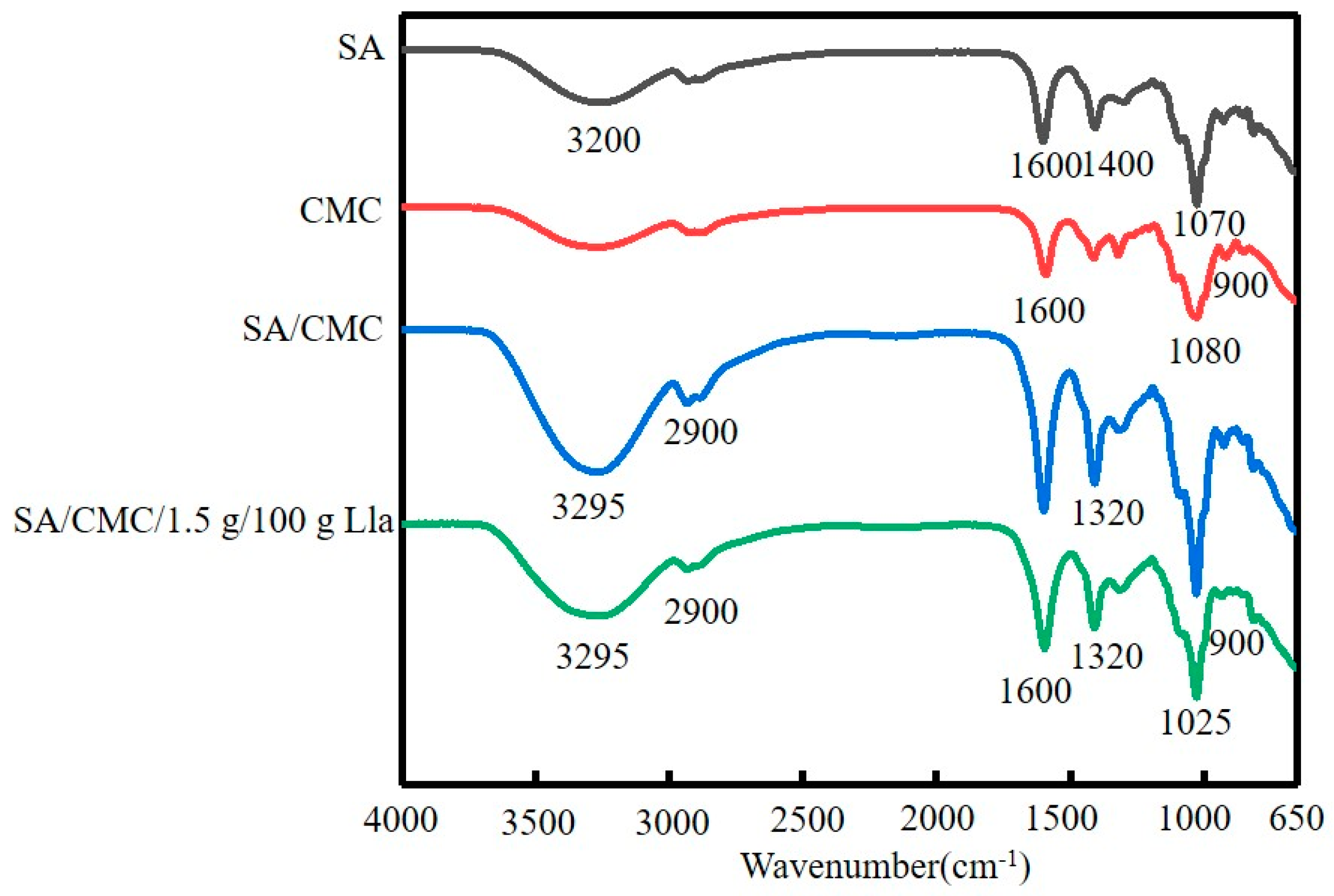
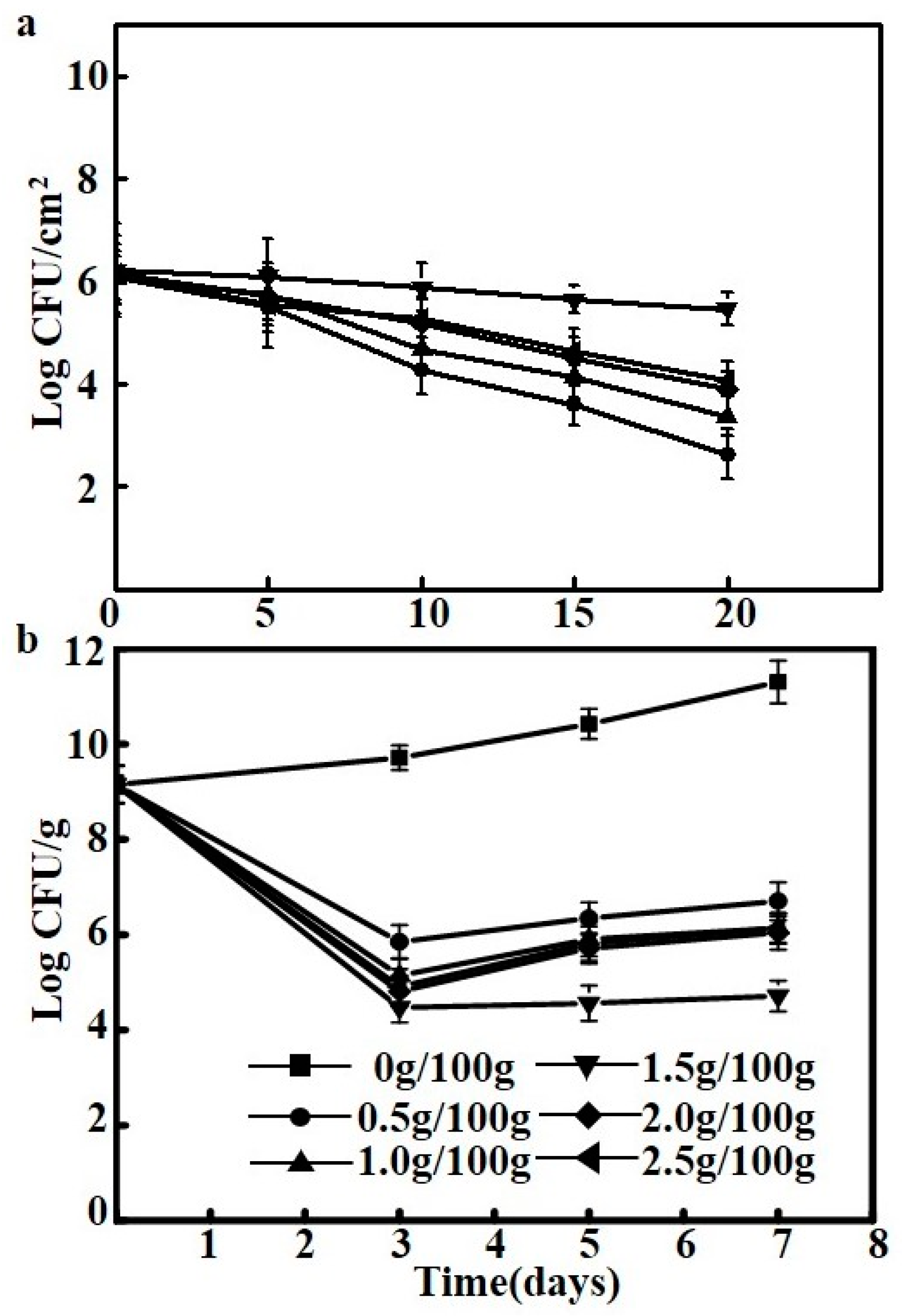
| Edible Film | Thickness (mm) | WVP (10−11 g m/m2 s Pa) | TS (MPa) | E (%) |
|---|---|---|---|---|
| SA/CMC/0 g/100 g Lla | 0.034 ± 0.02 a | 6.73 ± 0.68 cd | 27.23 ± 0.09 a | 24.86 ± 1.65 a |
| SA/CMC/0.5 g/100 g Lla | 0.034 ± 0.01 a | 6.09 ± 0.81 d | 24.42 ± 3.03 b | 24.17 ± 1.61 ab |
| SA/CMC/1.0 g/100 g Lla | 0.039 ± 0.02 a | 7.14 ± 0.91 c | 19.04 ± 2.66 c | 22.33 ± 1.51 bc |
| SA/CMC/1.5 g/100 g Lla | 0.041 ± 0.01 a | 8.60 ± 1.05 b | 16.89 ± 2.59 d | 21.13 ± 1.43 c |
| SA/CMC/2.0 g/100 g Lla | 0.041 ± 0.02 a | 9.31 ± 1.17 b | 9.34 ± 1.14 e | 14.18 ± 1.21 d |
| SA/CMC/2.5 g/100 g Lla | 0.043 ± 0.01 a | 10.25 ± 1.25 a | 7.50 ± 1.01 f | 9.19 ± 1.03 e |
| Edible Film | L* | a* | b* | △E |
|---|---|---|---|---|
| control | 88.45 ± 1.82 c | 0.60 ± 0.64 e | 0.90 ± 0.77 f | |
| SA/CMC/0 g/100 g Lla | 89.81 ± 1.81 a | 1.14 ± 0.77 d | 3.52 ± 0.35 e | 3.00 ± 0.45 c |
| SA/CMC/0.5 g/100 g Lla | 89.24 ± 1.63 b | 1.36 ± 0.87 c | 5.28 ± 0.67 c | 4.45 ± 0.58 b |
| SA/CMC/1.0 g/100 g Lla | 88.94 ± 1.57 b | 1.24 ± 0.81 d | 4.75 ± 0.54d | 4.00 ± 0.53 bc |
| SA/CMC/1.5 g/100 g Lla | 87.82 ± 1.43 d | 1.74 ± 0.14 b | 5.85 ± 0.79 b | 5.10 ± 0.66 b |
| SA/CMC/2.0 g/100 g Lla | 87.76 ± 1.41 d | 1.78 ± 0.15 ab | 5.84 ± 0.78 b | 5.09 ± 0.65 b |
| SA/CMC/2.5 g/100 g Lla | 87.06 ± 1.28 e | 1.86 ± 0.18 a | 7.69 ± 0.95 a | 7.05 ± 0.86 a |
© 2018 by the authors. Licensee MDPI, Basel, Switzerland. This article is an open access article distributed under the terms and conditions of the Creative Commons Attribution (CC BY) license (http://creativecommons.org/licenses/by/4.0/).
Share and Cite
Ye, J.; Ma, D.; Qin, W.; Liu, Y. Physical and Antibacterial Properties of Sodium Alginate—Sodium Carboxymethylcellulose Films Containing Lactococcus lactis. Molecules 2018, 23, 2645. https://doi.org/10.3390/molecules23102645
Ye J, Ma D, Qin W, Liu Y. Physical and Antibacterial Properties of Sodium Alginate—Sodium Carboxymethylcellulose Films Containing Lactococcus lactis. Molecules. 2018; 23(10):2645. https://doi.org/10.3390/molecules23102645
Chicago/Turabian StyleYe, Jingsong, Donghui Ma, Wen Qin, and Yaowen Liu. 2018. "Physical and Antibacterial Properties of Sodium Alginate—Sodium Carboxymethylcellulose Films Containing Lactococcus lactis" Molecules 23, no. 10: 2645. https://doi.org/10.3390/molecules23102645
APA StyleYe, J., Ma, D., Qin, W., & Liu, Y. (2018). Physical and Antibacterial Properties of Sodium Alginate—Sodium Carboxymethylcellulose Films Containing Lactococcus lactis. Molecules, 23(10), 2645. https://doi.org/10.3390/molecules23102645





